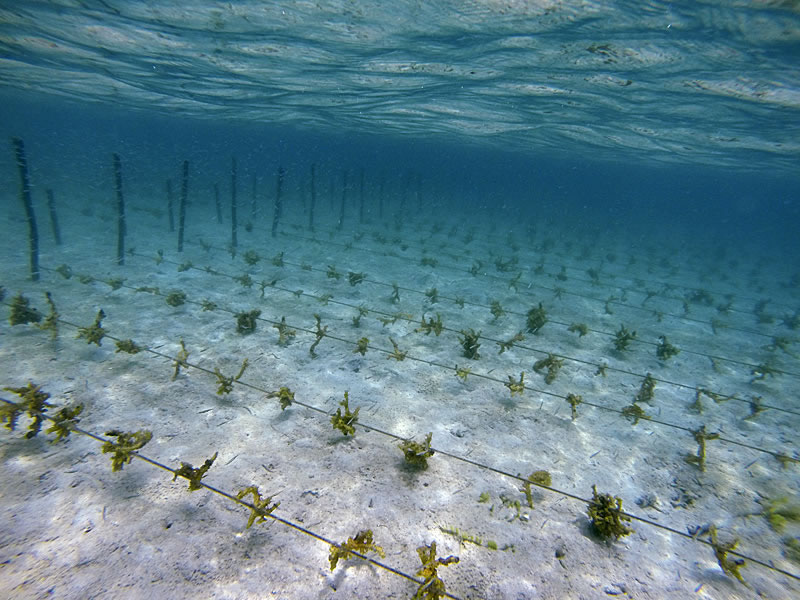Seaweed Farming
Seaweed farming is the practice of cultivating and harvesting various species of marine algae. This emerging industry has potential applications in food production, biofuel, and carbon sequestration, making it a promising solution for climate change mitigation.

Seaweed farm near Kia Village (Khaled bin Sultan Living Oceans Foundation)
Phyconomy is a great resource for tracking the seaweed farming industry
View open jobs in this Solution
Example Companies
- Seaweed Energy Solutions - Develops large-scale seaweed cultivation for biofuel production.
- GreenWave - Promotes regenerative ocean farming, including seaweed cultivation.
- Ocean Rainforest - Cultivates seaweed for food, feed, and bio-based materials.
- AtSeaNova - Provides turnkey solutions for seaweed farming.
- C-Combinator - Develops seaweed-based products for various industries.
Overview
Seaweed farming is developing as a potential solution to combat climate change, with advancements in cultivation techniques and processing technologies. The industry aims to leverage seaweed's ability to absorb carbon dioxide and provide sustainable alternatives to various products.
Progress Made
Significant advancements have been made in seaweed farming:
- Automated Farming Systems: Development of systems that reduce manual labor and increase efficiency.
- Seaweed Breeding Programs: Creation of disease-resistant strains and improved quality varieties.
- New Processing Technologies: Advancements in extracting valuable compounds like carrageenan and agar.
- Ocean Solution Farms: Innovative farms using photosynthesis to convert CO2 into seaweed biomass.
Solutions by Sector
Food and Agriculture
- Seaweed-Based Food Products: Developing seaweed as a nutritious and sustainable food source.
- Animal Feed Supplements: Using seaweed as a supplement in livestock feed to reduce methane emissions.
- Biofertilizers: Creating seaweed-based fertilizers for sustainable agriculture.
Case Studies:
- Ocean Rainforest, Faroe Islands: Cultivates seaweed for various applications, contributing to sustainable food production (Ocean Rainforest).
- SeaFarm, Portugal: Produces seaweed for food and cosmetic industries (SeaFarm).
- Atlantic Sea Farms, USA: Works with fishermen to grow kelp as a sustainable crop (Atlantic Sea Farms).
Energy and Materials
- Biofuel Production: Developing seaweed-based biofuels as a renewable energy source.
- Bioplastics: Creating biodegradable plastics from seaweed materials.
- Textile Fibers: Producing sustainable textile fibers from seaweed.
Case Studies:
- Seaweed Energy Solutions, Norway: Develops large-scale seaweed cultivation for biofuel production (Seaweed Energy Solutions).
- AlgiKnit, USA: Creates biodegradable yarns from kelp for the fashion industry (AlgiKnit).
- Loliware, USA: Produces seaweed-based alternatives to single-use plastics (Loliware).
Environmental Services
- Carbon Sequestration: Utilizing seaweed farms for carbon capture and storage.
- Water Quality Improvement: Using seaweed to remove excess nutrients from coastal waters.
- Habitat Restoration: Creating seaweed forests to support marine biodiversity.
Case Studies:
- The Climate Foundation, Global: Develops marine permaculture arrays for carbon sequestration (The Climate Foundation).
- GreenWave, USA: Promotes regenerative ocean farming, including seaweed cultivation (GreenWave).
- Blue Carbon Lab, Australia: Researches the carbon sequestration potential of coastal ecosystems (Blue Carbon Lab).
Lessons Learned
- Carbon Capture Potential: Seaweed farming can effectively capture CO2 and improve water quality.
- Ecosystem Benefits: Seaweed farms provide habitat for marine life while addressing climate change.
- Management Importance: Successful seaweed farming requires careful planning and management.
- Scalability Challenges: Scaling up production to make a significant climate impact remains a major challenge.
Challenges Ahead
- Scaling Production: Global seaweed production must increase significantly to make a substantial climate impact.
- Environmental Impact: Potential negative effects on local ecosystems need to be carefully monitored and mitigated.
- Market Development: Creating and expanding markets for seaweed products is crucial for industry growth.
- Technological Limitations: Current cultivation and processing technologies need further improvement for large-scale implementation.
Best Path Forward
- Research and Development: Invest in R&D to improve cultivation techniques, processing technologies, and product development.
- Policy Support: Implement supportive policies and regulations to encourage seaweed farming and its products.
- Public Awareness: Increase public understanding of the benefits of seaweed farming and its products.
- Industry Collaboration: Foster partnerships between researchers, farmers, and industries to drive innovation and market development.
- Sustainable Practices: Ensure that seaweed farming is conducted in an environmentally responsible manner.
Image credit: Khaled bin Sultan Living Oceans Foundation